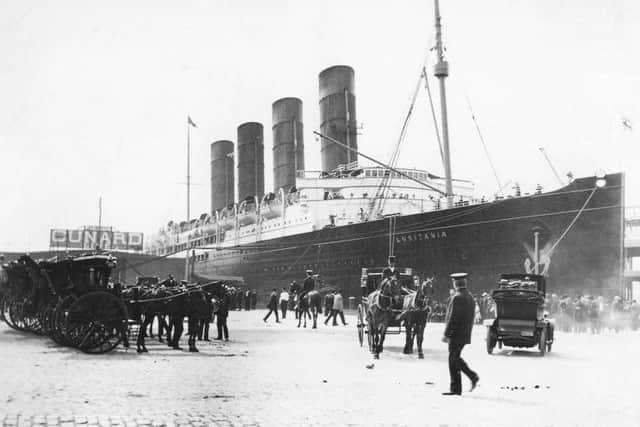Final voyage of the ill-fated Lusitania


This is the story of another of my Dad’s cousins, Walter Dawson Mitchell who drowned when the Lusitania was torpedoed by German submarine U-20, 100 years ago, on 7 May 1915.
Our common ancestors were George Mitchell and his wife Margaret Jane Patton. George Mitchell, my great-grandfather, was a school teacher and Clerk of Petty Sessions at Colehill, Newtowncunningham, County Donegal in second half of 19th century.
Advertisement
Hide AdAdvertisement
Hide AdTracing Walter’s family story in historical records is also of interest owing to inconsistency in use of first names. He was born as George Patton Mitchell in Lisburn in 1888, son of Reverend George Patton Mitchell, Rector of Drumbo Parish, County Down and Elizabeth D Pounden.


In the 1901 census Walter, age 13, is recorded as George P Mitchell and in the 1911 census, age 23, as Walter D Mitchell.
Indeed this search also confirms that researchers should always be aware of the possibility of errors in any transcription of records whether they be online or in a book.
In searching the index to the 1911 census, at www.census.nationalarchives.ie, Walter D Mitchell is ‘disguised’ as he was transcribed as Walker D Mitchell.
Advertisement
Hide AdAdvertisement
Hide AdIn 1912, when he married his childhood sweetheart, Jeanette Moore, his name is registered as Walter D G P Mitchell.
In other words Walter’s full name was Walter Dawson George Patton Mitchell. In adulthood he was simply known as Walter Mitchell.
According to the Lusitania resource website, at www.rmslusitania.info, Walter Mitchell, mill manager with Island Spinning Company in Lisburn was offered a job as assistant manager of Marshall Mills in Kearny, New Jersey in December of 1912.
Walter and his new wife Jeanette sailed, first class, from Londonderry on 28 December 1912 on the Anchor Line ship, California, bound for New York.
Advertisement
Hide AdAdvertisement
Hide AdI was able to view and print this passenger manifest by accessing Ancestry Library Edition in Derry Central Library.
By 1912 Londonderry was the major emigration port to North America for those who resided in the northern half of Ireland; Queenstown (Cobh) for the southern half. From 1861 right through to 1939 ocean-going liners called at Moville, in the deeper waters of Lough Foyle, some 18 miles downstream from Londonderry, to pick up emigrants who were ferried from Derry in paddle tenders.
In 1912, the Anchor Line Shipping Company employed four ships, Cameronia, California, Caledonia and Columbia on its ‘American Express Passenger Service’ from Londonderry to New York.
The rooms inside the Anchor Line’s prestigious headquarters, built 1905-7, at 12-16 St Vincent Place, Glasgow were designed by Glasgow architect James Miller with the opulence of an ocean liner as James Miller also designed interiors for RMS Lusitania.
Advertisement
Hide AdAdvertisement
Hide AdThe Lusitania Resource website continues the story: ‘Walter and Jeanette lived with Mrs. R.M. Crozier of 177 Broad Street, Newark, New Jersey and, in August 1914, their son Walter was born. In the spring of 1915, the Mitchells decided to return to Ireland to visit their parents in Lisburn.
Also travelling with the Mitchells would be Jeanette’s brother, John Moore, who had been living in Connecticut since 1911 and planned to enlist for the war effort once he reached Ireland.
Walter, Jeanette, their ten-month-old son, and John booked their passage on Lusitania. Walter and Walter, Junior, were both lost in the Lusitania disaster, but Jeanette and John were saved.’
RMS Lusitania, launched by the Cunard Line in 1906, was briefly the world’s biggest ship.
Advertisement
Hide AdAdvertisement
Hide AdLusitania and her sister ship Mauretania were fitted with revolutionary new turbine engines, able to maintain a speed of 25 knots.
Equipped with lifts, wireless telegraph and electric light, they provided 50% more passenger space than any other ship, and the first class decks were noted for their sumptuous furnishings.
The Lusitania set sail from Cunard’s Pier 54 in New York on 1 May 1915, with 1,959 passengers and crew, destined for Liverpool, via Cobh.
Everyone knew that submarines were becoming an increasing threat to shipping in the Atlantic in the nine months since Britain had declared war on Germany. Germany had declared the waters around the United Kingdom a war zone and that vessels flying the flag of Great Britain were ‘liable to destruction’.
Advertisement
Hide AdAdvertisement
Hide AdThere was widespread use of civilian ships in the war effort (carrying munitions, troops).